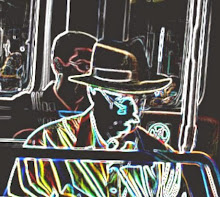
The death of Robert Moog was announced today, causing many
of us to reflect on the size of the contributions he made to
electronic music.
It's easy to forget now how primitive the equipment was and
how difficult to work with prior to Moog's development of the
first "synthesizer." Composition in those days (prior to 1967
or so) was a labor for lab technicians using oscilloscopes to study
wave forms produced by oscillators, and modifying them with
amplifiers and filter circuits. Much was also done by
manipulating magnetic tape, physically splicing different tones
together and altering the speed and direction of playback.
Moog's packaged system created new possibilities which are
still being explored today. By bundling an assortment of
oscillators, amplifiers and filters together, and allowing them
to be "patched" together in various ways (using "patch cords"
that plugged into the panel like an old telephone switchboard),
and finally by allowing the whole thing to be controlled by a
piano-style keyboard, he created a truly playable instrument.
Wendy (née Walter) Carlos arranged and played Bach on the
thing, and the world was never the same. It's hard to remember
now, with all the electronic tones in the air, what a revolution
that "Switched-On Bach" sound was at the beginning. You
actually had to learn how to hear it.
One track in particular, the slow movement Carlos improvised
for the Brandenburg Concerto, sounded at first like a bewildering
mix of sound effects that had nothing to do with traditional scales
and notes. Then one day when I was, shall we say, intoxicated
(it was the 60's, after all!), I discovered that I could remember
and "play back" in my mind the whole thing, with all the electronic
bells and whistles. My brain had figured out how to listen, and had
recorded it for me. Afterwards, when I played the record again,
I could hear the traditional baroque-styled notes that underlay
the sounds, and it seemed perfectly comprehensible.
Like every great invention, the Moog synthesizer was rapidly
imitated and improved upon by others. The machines became
easier to "patch," using knobs and buttons instead of cords.
They became polyphonic (the early ones could only produce one
note at a time, and recordings had to be made of many tracks put
down in layers). The electronic modules that produced the sounds
kept shrinking, riding the parallel wave of computer technology,
until whole synthesizers were reduced to the size of chips. Finally,
they have become purely digital, and hard to distinguish from
computers themselves.
It's a wonderful footnote to Moog's life that his early interest in
electronic music dates back to his childhood when he built a theremin
from instructions in an electronics magazine. The theremin, named
after it's 1919 inventor Leon Theremin, is a purely analog device
played with a pair of antennas that respond to proximity. One
antenna controls pitch while the other controls volume. Though
simple in principle, the thing is darn hard to play. Anyone can make
weird sci-fi UFO whistles, but few have had the patience to learn
the control necessary to play real music, which is why it has
remained a curiousity rather than developing into a mainstream
instrument.
Late in his life Moog saw to it that one of the few theremin virtuosos,
Clara Rockmore, was properly recorded for posterity. Her album
very simply has no peer. In her hands (or maybe I should say, near
her hands) the instrument literally sings, sounding like a cross
between a viola and a contralto voice. Her performance of the
Rachmaninoff "Vocalise" deserves to be legendary.
So in returning to the roots of his inspiration Moog left us with yet
another gift. Thanks for everything, Bob!
Tuesday, August 23, 2005
Farewell to Robert Moog
Posted by
The Nort
at
5:52 PM
![]()
![]()
Labels: electronic music, moog, synthesizer, theremin
Subscribe to:
Post Comments (Atom)









Erratum -- I have discovered that the Clara Rockmore recording actually dates back to 1977, and was later reissued on CD.
ReplyDelete